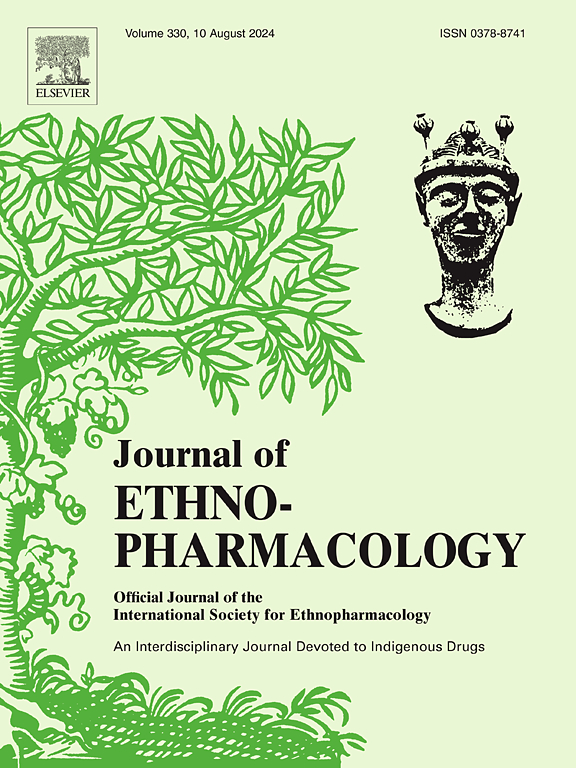Amygdalin's neuroprotective effects on acute ischemic stroke in rats
IF 4.8
2区 医学
Q1 CHEMISTRY, MEDICINAL
引用次数: 0
Abstract
Ethnopharmacological relevance
Amygdalin, a key component of Peach kernel (semen persicae), also known as Taoren, is a traditional Chinese herb known for promoting blood circulation and alleviating blood stasis, especially in stroke treatment. This study aimed to explore the effects of amygdalin on neurological function in a rat model of acute ischemic stroke.
Methods
We induced acute ischemic stroke in Sprague-Dawley rats by occluding the right middle cerebral artery (MCAO) for 30 min, followed by reperfusion. Amygdalin was administered intraperitoneally at doses of 5 mg, 10 mg, and 20 mg per kilogram starting 24 h post-reperfusion for three consecutive days. We assessed cerebral infarct volume and neurological function, and analyzed the brain tissue using western blotting.
Results
Amygdalin significantly reduced cerebral infarct volume resulting from MCAO in the 5-mg group (amygdalin 5 mg/kg; 18.02 ± 7.51 %), 10-mg group (amygdalin 10 mg/kg; 16.25 % ± 6.35 %) and 20-mg group (amygdalin 20 mg/kg; 12.26 ± 6.69 %) compared to the sham group (phosphate buffer saline; 28.99 ± 6.36 %) (all p < 0.001). The 10-mg and 20-mg groups showed significantly lower modified neurological severity scores (mNSS) than the sham group 5 days post-reperfusion (p < 0.05, p < 0.0001, respectively). Performance on the rotarod test also improved significantly in the 10-mg group (p < 0.05) and 20-mg group (p < 0.0001) compared to the sham group, and the distance traveled in the open-field test increased significantly in the 5-mg group (p < 0.001), 10-mg group (p < 0.0001) and 20-mg group (p < 0.0001) compared to the sham group. Western blotting revealed that the expression of uncleaved caspase-3 in the cerebral cortex was greater in the sham group compared to the control (without MCAO and treatment) and the 20-mg groups (both p < 0.05), while the expression of caspase-9 was greater in the control and 20-mg groups than in the sham group (both p < 0.05).
Conclusion
Intraperitoneal administration of amygdalin for three days reduced cerebral infarct volume and improved neurological function in a rat model of acute ischemic stroke. Additionally, amygdalin decreased uncleaved caspase-3 expression and increased caspase-9 expression. The findings suggest that amygdalin plays a neuroprotective role through modulation of apoptosis process via the intrinsic pathway.

民族药理学意义桃仁中的主要成分苦杏仁苷是一种传统中药,具有活血化瘀的功效,尤其适用于中风的治疗。本研究旨在探讨桃仁苷对急性缺血性脑卒中模型大鼠神经功能的影响。方法我们通过闭塞右侧大脑中动脉(MCAO)30 分钟诱导 Sprague-Dawley 大鼠发生急性缺血性脑卒中,然后进行再灌注。再灌注后 24 小时开始腹腔注射杏仁苷,剂量分别为每公斤 5 毫克、10 毫克和 20 毫克,连续注射三天。我们对脑梗死体积和神经功能进行了评估,并使用 Western 印迹技术对脑组织进行了分析。结果 在 5 毫克组,杏仁苷显著减少了 MCAO 导致的脑梗死体积(杏仁苷 5 毫克/千克;18.与假组(磷酸盐缓冲盐水;28.99 ± 6.36 %)相比,5 毫克组(杏仁苷 5 毫克/千克;18.02 ± 7.51 %)、10 毫克组(杏仁苷 10 毫克/千克;16.25 % ± 6.35 %)和 20 毫克组(杏仁苷 20 毫克/千克;12.26 ± 6.69 %)的杏仁苷可明显减少 MCAO 导致的脑梗死体积(所有 p 均为 0.001)。再灌注后 5 天,10 毫克组和 20 毫克组的改良神经严重程度评分(mNSS)明显低于假体组(分别为 p < 0.05 和 p < 0.0001)。与假体组相比,10 毫克组(p < 0.05)和 20 毫克组(p < 0.0001)的转体测试成绩也有显著改善,与假体组相比,5 毫克组(p < 0.001)、10 毫克组(p < 0.0001)和 20 毫克组(p < 0.0001)的开阔地测试距离显著增加。Western 印迹显示,与对照组(无 MCAO 和治疗)和 20 毫克组相比,假组大脑皮层中未解离的 caspase-3 的表达量更高(均为 p < 0.结论在急性缺血性脑卒中大鼠模型中,腹腔注射苦杏仁苷三天可减少脑梗死体积并改善神经功能。此外,苦杏仁苷还能降低未凋亡caspase-3的表达,增加caspase-9的表达。研究结果表明,苦杏仁苷可通过内在途径调节细胞凋亡过程,从而起到保护神经的作用。
本文章由计算机程序翻译,如有差异,请以英文原文为准。
求助全文
约1分钟内获得全文
求助全文
来源期刊

Journal of ethnopharmacology
医学-全科医学与补充医学
CiteScore
10.30
自引率
5.60%
发文量
967
审稿时长
77 days
期刊介绍:
The Journal of Ethnopharmacology is dedicated to the exchange of information and understandings about people''s use of plants, fungi, animals, microorganisms and minerals and their biological and pharmacological effects based on the principles established through international conventions. Early people confronted with illness and disease, discovered a wealth of useful therapeutic agents in the plant and animal kingdoms. The empirical knowledge of these medicinal substances and their toxic potential was passed on by oral tradition and sometimes recorded in herbals and other texts on materia medica. Many valuable drugs of today (e.g., atropine, ephedrine, tubocurarine, digoxin, reserpine) came into use through the study of indigenous remedies. Chemists continue to use plant-derived drugs (e.g., morphine, taxol, physostigmine, quinidine, emetine) as prototypes in their attempts to develop more effective and less toxic medicinals.
 求助内容:
求助内容: 应助结果提醒方式:
应助结果提醒方式:


